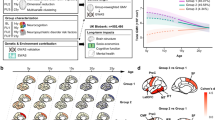Abstract
1. After weaning, human hunter-gatherer juveniles receive substantial (≈3.5-7 MJ day^-1^), extended (≈15 years) and reliable (kin and nonkin food pooling) energy provision.2. The childhood (pediatric) and the adult human brain takes a very high share of both basal metabolic rate (BMR) (child: 50-70%; adult: ≈20%) and total energy expenditure (TEE) (child: 30-50%; adult: ≈10%).3. The pediatric brain for an extended period (≈4-9 years-of-age) consumes roughly 50% more energy than the adult one, and after this, continues during adolescence, at a high but declining rate. Within the brain, childhood cerebral gray matter has an even higher 1.9 to 2.2-fold increased energy consumption. 4. This metabolic expensiveness is due to (i) the high cost of synapse activation (74% of brain energy expenditure in humans), combined with (ii), a prolonged period of exuberance in synapse numbers (up to double the number present in adults). Cognitive development during this period associates with volumetric changes in gray matter (expansion and contraction due to metabolic related size alterations in glial cells and capillary vascularization), and in white matter (expansion due to myelination). 5. Amongst mammals, anatomically modern humans show an unique pattern in which very slow musculoskeletal body growth is followed by a marked adolescent size/stature spurt. This pattern of growth contrasts with nonhuman primates that have a sustained fast juvenile growth with only a minor period of puberty acceleration. The existence of slow childhood growth in humans has been shown to date back to 160,000 BP. 6. Human children physiologically have a limited capacity to protect the brain from plasma glucose fluctuations and other metabolic disruptions. These can arise in adults, during prolonged strenuous exercise when skeletal muscle depletes plasma glucose, and produces other metabolic disruptions upon the brain (hypoxia, hyperthermia, dehydration and hyperammonemia). These are proportional to muscle mass.7. Children show specific adaptations to minimize such metabolic disturbances. (i) Due to slow body growth and resulting small body size, they have limited skeletal muscle mass. (ii) They show other adaptations such as an exercise specific preference for free fatty acid metabolism. (iii) While children are generally more active than adolescents and adults, they avoid physically prolonged intense exertion. 8. Childhood has a close relationship to high levels of energy provision and metabolic adaptations that support prolonged synaptic neurodevelopment.
Similar content being viewed by others
Article PDF
Author information
Authors and Affiliations
Corresponding author
Rights and permissions
About this article
Cite this article
Skoyles, J. Human metabolic adaptations and prolonged expensive neurodevelopment: A review. Nat Prec (2008). https://doi.org/10.1038/npre.2008.1856.2
Received:
Accepted:
Published:
DOI: https://doi.org/10.1038/npre.2008.1856.2



